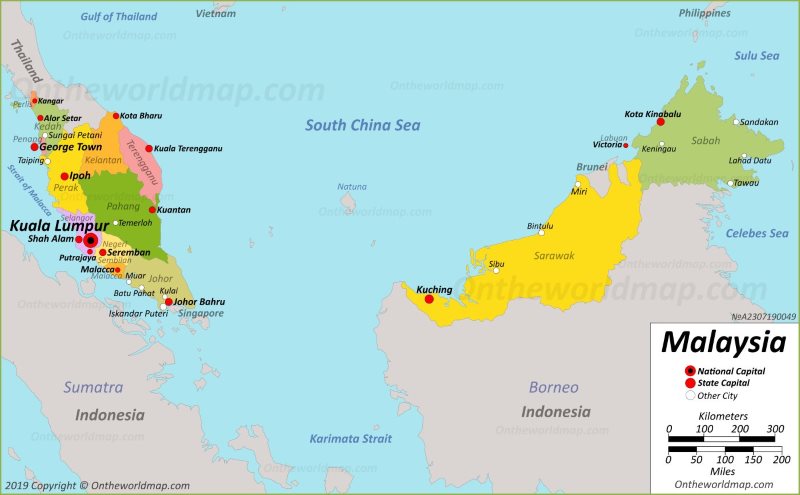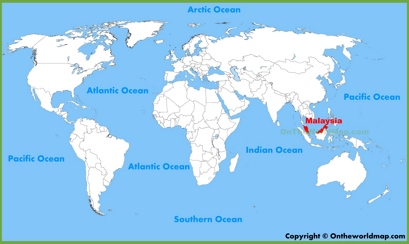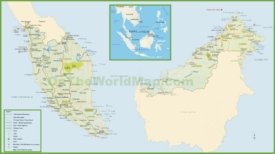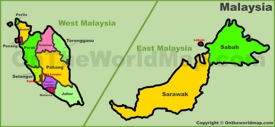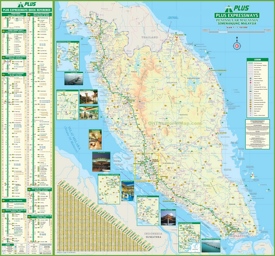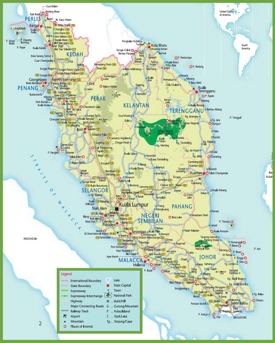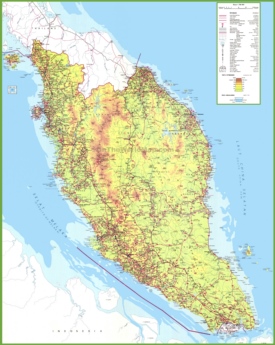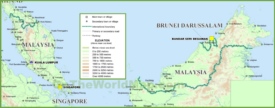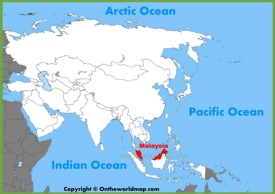Malaysia Map
Description:
This map shows governmental boundaries of countries; islands, states, state capital cities, major cities and towns in Malaysia.
Size: 1500x927px / 276 Kb | 1400x866px / 137 Kb
Author: Ontheworldmap.com
You may download, print or use the above map for educational, personal and non-commercial purposes. Attribution is required. For any website, blog, scientific research or e-book, you must place a hyperlink (to this page) with an attribution next to the image used.
Online Map of Malaysia
Detailed Maps of Malaysia
About Malaysia
Malaysia, located in Southeast Asia, consists of two main regions: Peninsular Malaysia and East Malaysia on the island of Borneo. Peninsular Malaysia borders Thailand to the north, has maritime borders with Singapore to the south, the country also borders Indonesia and Brunei on the island of Borneo. The maritime borders include the South China Sea, which separates the two regions. Malaysia has an area of about 127,724 square miles (330,803 square kilometers) and a population of about 34.5 million.
The capital, Kuala Lumpur, is a cultural and economic center known for its modern skyline, including the iconic Petronas Twin Towers. Other major cities include George Town on Penang, a UNESCO World Heritage Site, and Johor Bahru, a major industrial and commercial center.
Malaysia's economy is the third largest in Southeast Asia and is characterized by a diverse mix of agriculture, manufacturing, and services. The country is a leading exporter of palm oil, rubber, and electronics, and has a strong focus on the oil and gas sector. The government is pursuing policies aimed at economic diversification and technological advancement in an effort to achieve high-income status.
Malaysia's strategic location along major sea lanes enhances its role in international trade. The country is investing in infrastructure development to support economic growth, focusing on transportation, digital connectivity and energy. In addition, Malaysia is focusing on education and healthcare development to enhance human capital development.
Tourism contributes significantly to the country's economy, with attractions ranging from tropical beaches and rainforests to vibrant urban centers. Efforts to promote sustainable tourism are aimed at balancing economic benefits with environmental preservation.
Malaysia continues to address challenges such as income inequality and environmental sustainability while capitalizing on its diverse economy and strategic position in the region.
The Facts:
| Capital: | Kuala Lumpur |
| Area: | 127,724 sq mi (330,803 sq km) |
| Population (2024): | 34,564,810 |
| Official language: | Malay |
| Currency: | Malaysian ringgit (RM) (MYR) |
| Driving side: | left |
| Calling code: | +60 |
| Internet TLD: | .my |
| Time zone: | UTC+8 (MST) |
| Gross domestic product 2024 (PPP): |
|
| Gross domestic product 2024 (nominal): |
|
List of Largest Cities in Malaysia
- Kuala Lumpur
- Kajang
- Seberang Perai
- Petaling Jaya
- Klang
- Johor Bahru
- Shah Alam
- George Town
- Subang Jaya
- Selayang
- Ipoh
- Seremban
- Iskandar Puteri
- Kuantan
- Sungai Petani
- Ampang Jaya
- Kota Kinabalu
- Malacca City
- Sandakan
- Alor Setar
- Tawau
- Batu Pahat
- Kota Bharu
- Kuala Terengganu
- Kuching
- Sepang
- Kulim
- Muar
- Pasir Gudang
- Kuala Langat
- Kulai
- Kangar
- Kuala Selangor
States of Malaysia
- Johor
- Kedah
- Kelantan
- Malacca
- Negeri Sembilan
- Pahang
- Penang
- Perak
- Perlis
- Sabah
- Sarawak
- Selangor
- Terengganu
Federal Territories of Malaysia
Geography of Malaysia
Malaysia, located in Southeast Asia, consists of two main regions: Peninsular Malaysia and East Malaysia on the island of Borneo. These regions are separated by the South China Sea. Peninsular Malaysia borders Thailand to the north and Singapore to the south, while East Malaysia borders Indonesia and Brunei.
The country is characterized by a variety of geographical landscapes: coastal plains, mountainous areas and dense tropical forests. The Titiwangsa Mountains run through Peninsular Malaysia, while the Crocker Range dominates East Malaysia.
Malaysia has a tropical rainforest climate characterized by high humidity and constant temperatures throughout the year. The average temperature ranges from 77°F to 95°F (25°C-35°C). The country has two monsoon seasons: the southwest monsoon from May through September and the northeast monsoon from November through March, bringing heavy rainfall.
The diverse climate and geography support a rich biodiversity, making Malaysia home to many endemic species and vital ecosystems. The government emphasizes conservation to protect these natural resources while balancing economic development.
Island of Malaysia: Penang, Langkawi, Borneo.
Brief History of Malaysia
The history of Malaysia reflects the fusion of indigenous cultures and foreign influences. Early Malay kingdoms such as Langkasuka and Srivijaya paved trade routes and established cultural exchange in the region. By the 15th century, the Malacca Sultanate had become a major trading center, attracting merchants from all over Asia and Europe.
In the 16th century, European powers, beginning with the Portuguese and later the Dutch and British, sought control of Malacca because of its strategic position. British colonial rule spread in the nineteenth century, uniting the various Malay states into the Federated and Unfederal Malay States.
Malaysia gained independence from Britain in 1957, forming the Federation of Malaya. In 1963, it incorporated Sabah, Sarawak and Singapore and became Malaysia. Singapore seceded in 1965. Malaysia's history shapes its multicultural society and trajectory of development.
Maps of Malaysia
Cities of Malaysia
Islands of Malaysia

